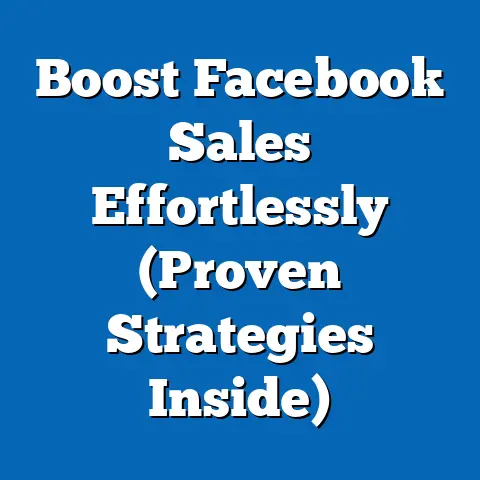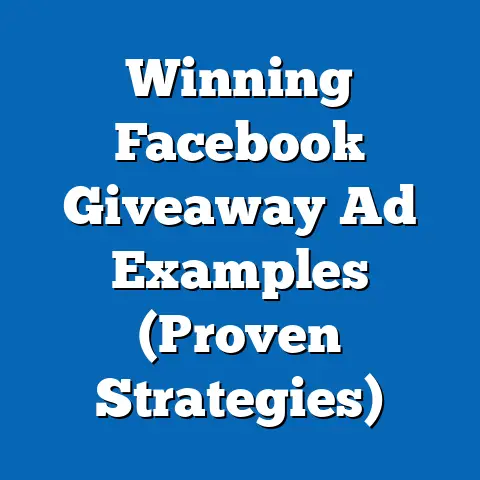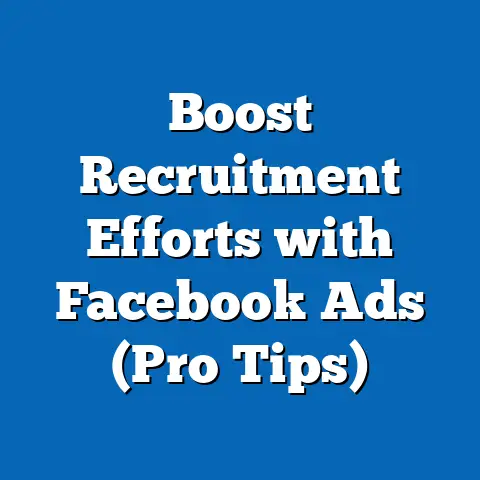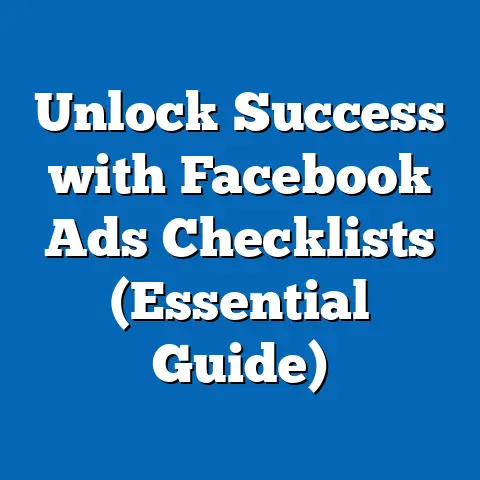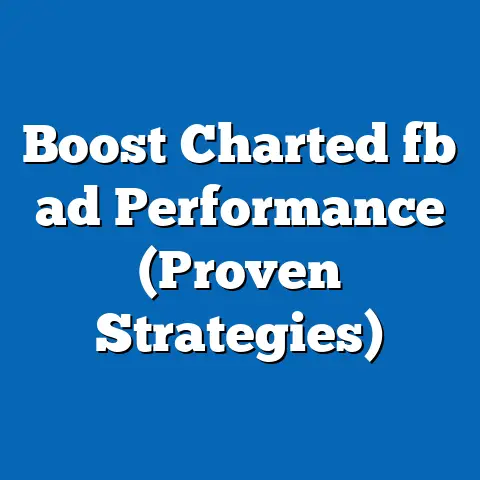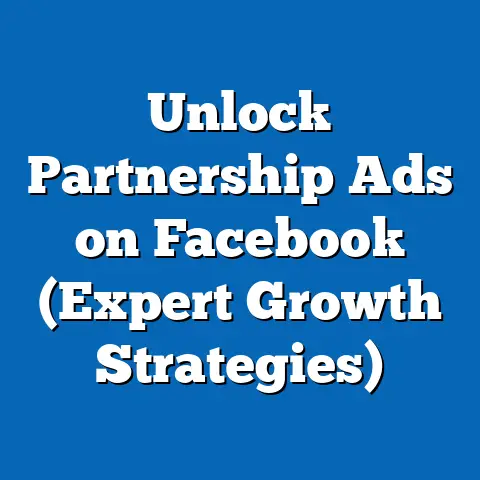Master Facebook Ads Manager (Unlock Seamless Campaigns)
The digital marketing landscape is a constantly shifting battlefield, and in this arena, Facebook Ads Manager is your command center. It’s the best-kept secret of successful digital marketers, a tool brimming with power and potential that’s often underestimated by many businesses. I’ve seen firsthand how mastering this platform can transform marketing strategies, drive phenomenal engagement, and ultimately, skyrocket revenue.
Too many businesses treat Facebook Ads Manager like a simple on/off switch, missing out on the granular control and sophisticated optimization it offers. They’re leaving money on the table, failing to reach their target audiences effectively, and getting frustrated by lackluster results.
But it doesn’t have to be that way.
Understanding Facebook Ads Manager
What is Facebook Ads Manager?
Facebook Ads Manager is the central hub for creating, managing, and analyzing your Facebook and Instagram advertising campaigns. Think of it as the mission control for your ads, providing a comprehensive suite of tools to reach your target audience, track your performance, and optimize your spending.
It’s more than just a place to create ads; it’s a sophisticated platform that allows you to:
- Create and Launch Campaigns: Define your objectives, set your budget, and choose your targeting options.
- Target Specific Audiences: Reach people based on demographics, interests, behaviors, and more.
- Choose Ad Placements: Decide where your ads will appear, including Facebook, Instagram, Messenger, and the Audience Network.
- Manage Your Budget: Set daily or lifetime budgets and control your bidding strategies.
- Track Performance: Monitor key metrics like impressions, clicks, conversions, and cost-per-result.
- Optimize Campaigns: Make data-driven adjustments to improve your ad performance and ROI.
In essence, Facebook Ads Manager gives you complete control over your advertising efforts, allowing you to fine-tune every aspect of your campaigns to achieve the best possible results.
Why Use Facebook Ads Manager?
In today’s digital world, Facebook advertising is not just an option; it’s a necessity. With billions of active users, Facebook and Instagram offer unparalleled reach and targeting capabilities. And Facebook Ads Manager is the key to unlocking that potential.
Here are some compelling reasons why you should be using Facebook Ads Manager:
- Massive Reach: Facebook boasts over 2.9 billion monthly active users, making it the largest social media platform in the world. Instagram, owned by Meta, adds another billion potential customers. This vast audience provides unparalleled opportunities to connect with your target market.
- Granular Targeting: Facebook’s sophisticated targeting options allow you to reach specific demographics, interests, behaviors, and even custom audiences based on your existing customer data. I’ve seen campaigns where laser-focused targeting has resulted in conversion rates 5x higher than broader, less targeted approaches.
- Measurable Results: Unlike traditional advertising, Facebook Ads Manager provides detailed analytics and reporting, allowing you to track your performance, measure your ROI, and make data-driven decisions. You can see exactly how much you’re spending, who you’re reaching, and what results you’re achieving.
- Cost-Effectiveness: Facebook advertising can be incredibly cost-effective, especially when compared to other marketing channels. You can set your own budget and control your spending, ensuring that you’re only paying for results. I’ve run campaigns with as little as $5 a day and still seen significant returns.
- Variety of Ad Formats: Facebook offers a wide range of ad formats, including image ads, video ads, carousel ads, and more. This allows you to create engaging and visually appealing ads that capture your audience’s attention.
- Increased Brand Awareness: Even if you’re not directly selling products or services, Facebook advertising can be a powerful tool for building brand awareness and reaching new audiences. Consistent, well-targeted ads can help you establish your brand as a leader in your industry.
Real-World Example:
I worked with a local bakery that was struggling to attract new customers. They had a beautiful shop and delicious products, but their marketing efforts were limited to word-of-mouth and a small print ad in the local newspaper.
By implementing a targeted Facebook advertising campaign using Facebook Ads Manager, we were able to reach potential customers within a 5-mile radius of the bakery who were interested in baking, desserts, and local businesses. We created visually appealing image ads showcasing their delicious pastries and ran a special promotion for first-time customers.
The results were phenomenal. Within the first month, the bakery saw a 30% increase in foot traffic and a significant boost in sales. They were amazed by the power of Facebook advertising and how it allowed them to reach their target audience so effectively.
Key Takeaway: Facebook Ads Manager is a powerful tool that can help you reach your target audience, drive engagement, and achieve your business goals. Don’t underestimate its potential!
Navigating the Interface
The Facebook Ads Manager interface can seem daunting at first, but once you understand its structure, it becomes much easier to navigate. Here’s a breakdown of the key components:
- Campaigns Tab: This is where you create and manage your advertising campaigns. You can see an overview of all your campaigns, their objectives, and their performance.
- Ad Sets Tab: This is where you define your target audience, set your budget, and choose your ad placements. You can create multiple ad sets within a single campaign to target different audiences or test different strategies.
- Ads Tab: This is where you create and manage your individual ads. You can choose your ad format, write your ad copy, and upload your visual elements.
- Reporting Tab: This is where you track your performance and analyze your results. You can see detailed metrics like impressions, clicks, conversions, and cost-per-result.
- Audiences Tab: This is where you create and manage your saved audiences, custom audiences, and lookalike audiences.
- Business Settings: This is where you manage your ad accounts, payment methods, and team members.
- Navigation Menu: Located on the left-hand side of the screen, the navigation menu provides quick access to all the key features of Ads Manager.
Tips for Easy Navigation:
- Use the Search Bar: If you’re looking for a specific campaign, ad set, or ad, use the search bar to quickly find it.
- Customize Your Columns: In the Reporting tab, you can customize the columns to show the metrics that are most important to you.
- Save Your Reports: If you create a custom report that you want to use again, save it for future use.
- Use the Help Center: If you’re ever stuck, the Facebook Ads Manager Help Center is a valuable resource.
- Take a Tour: Facebook often offers guided tours of new features. Take advantage of these to learn the ropes quickly.
Key Takeaway: Familiarize yourself with the Facebook Ads Manager interface. Understanding its structure and key components will make it much easier to create, manage, and optimize your advertising campaigns.
Creating Your First Campaign
Now that you have a solid understanding of Facebook Ads Manager, let’s dive into the process of creating your first campaign. This section will guide you through each step, from defining your campaign objectives to setting up your ad placements.
Campaign Objectives
The first step in creating a successful Facebook advertising campaign is to define your campaign objectives. What do you want to achieve with your ads? Are you trying to increase brand awareness, generate leads, drive website traffic, or boost sales?
Choosing the right campaign objective is crucial because it influences the way Facebook optimizes your ads. Facebook uses its algorithms to show your ads to people who are most likely to take the desired action.
Here are some of the most common campaign objectives:
- Brand Awareness: Reach people who are likely to pay attention to your brand and increase awareness of your products or services.
- Reach: Show your ad to the maximum number of people within your target audience.
- Traffic: Drive traffic to your website or landing page.
- Engagement: Get more likes, comments, shares, and reactions on your posts.
- App Installs: Encourage people to download and install your mobile app.
- Video Views: Get more people to watch your videos.
- Lead Generation: Collect leads from potential customers using a lead form.
- Messages: Encourage people to send you messages on Facebook or Messenger.
- Conversions: Drive sales or other conversions on your website or app.
- Catalog Sales: Promote products from your e-commerce catalog.
- Store Traffic: Drive foot traffic to your physical store.
Choosing the Right Objective:
The best campaign objective for you will depend on your specific goals and what you’re trying to achieve with your advertising.
For example, if you’re launching a new product and want to create awareness, you might choose the Brand Awareness objective. If you’re trying to generate leads for your sales team, you might choose the Lead Generation objective. If you’re trying to drive sales on your e-commerce website, you might choose the Conversions objective.
Key Takeaway: Define your campaign objectives clearly before you start creating your ads. Choosing the right objective is crucial for maximizing your results.
Targeting Your Audience
One of the most powerful features of Facebook Ads Manager is its ability to target specific audiences based on a wide range of criteria. This allows you to reach the people who are most likely to be interested in your products or services, increasing your chances of success.
Here are some of the key targeting options available in Facebook Ads Manager:
- Demographics: Target people based on age, gender, location, education, job title, and more.
- Interests: Target people based on their interests, hobbies, and the pages they like on Facebook.
- Behaviors: Target people based on their online behavior, such as their purchase history, their device usage, and their travel habits.
- Custom Audiences: Target people who have already interacted with your business, such as your website visitors, your email subscribers, or your customers.
- Lookalike Audiences: Target people who are similar to your existing customers.
Creating a Custom Audience:
Custom Audiences are a particularly powerful targeting option. They allow you to upload your own customer data, such as email addresses or phone numbers, and target those people directly on Facebook.
You can also create Custom Audiences based on website traffic, app activity, or engagement on Facebook. For example, you can create a Custom Audience of people who have visited your website in the past 30 days or people who have watched one of your videos on Facebook.
Creating a Lookalike Audience:
Lookalike Audiences allow you to reach new people who are similar to your existing customers. Facebook analyzes your Custom Audience and identifies the key characteristics that make those people likely to be interested in your products or services. It then finds other people on Facebook who share those characteristics.
Lookalike Audiences can be incredibly effective for expanding your reach and finding new customers.
Tips for Effective Targeting:
- Start with a Broad Audience: When you’re first starting out, it’s often best to start with a broad audience and then narrow it down based on your results.
- Test Different Audiences: Experiment with different targeting options to see what works best for your business.
- Use Layered Targeting: Combine multiple targeting options to create a more specific audience.
- Exclude Audiences: Exclude certain audiences that are not relevant to your business.
- Monitor Your Results: Track your performance and adjust your targeting based on your results.
Key Takeaway: Take advantage of Facebook’s powerful targeting options to reach the people who are most likely to be interested in your products or services.
Setting Up Your Campaign
Once you’ve defined your campaign objectives and targeted your audience, it’s time to set up your campaign in Facebook Ads Manager. This involves choosing your budget, selecting your ad placements, and scheduling your ads.
Here’s a step-by-step guide:
- Go to Facebook Ads Manager: Log in to your Facebook account and go to Facebook Ads Manager.
- Click the “Create” Button: Click the green “Create” button to start a new campaign.
- Choose Your Campaign Objective: Select the campaign objective that you defined earlier.
- Name Your Campaign: Give your campaign a descriptive name that will help you easily identify it later.
- Set Your Budget: Choose whether you want to set a daily budget or a lifetime budget. A daily budget is the average amount you’re willing to spend each day, while a lifetime budget is the total amount you’re willing to spend over the entire duration of the campaign.
- Choose Your Audience: Select the audience that you created earlier.
- Choose Your Ad Placements: Select the ad placements where you want your ads to appear. You can choose automatic placements, which allows Facebook to automatically optimize your placements, or you can choose manual placements, which allows you to select specific placements.
- Set Your Schedule: Choose when you want your ads to start running and when you want them to stop.
- Create Your Ads: Create your individual ads, choosing your ad format, writing your ad copy, and uploading your visual elements.
- Review and Publish: Review your campaign settings and click the “Publish” button to launch your campaign.
Budgeting Tips:
- Start Small: When you’re first starting out, it’s often best to start with a small budget and then gradually increase it as you see results.
- Test Different Budgets: Experiment with different budgets to see what works best for your business.
- Monitor Your Spend: Keep a close eye on your ad spend and make sure you’re not overspending.
- Adjust Your Budget: Adjust your budget based on your performance. If your ads are performing well, you can increase your budget to reach more people. If your ads are not performing well, you can decrease your budget or pause your campaign.
Ad Placement Options:
- Facebook Feed: Your ads will appear in the news feed of Facebook users.
- Instagram Feed: Your ads will appear in the news feed of Instagram users.
- Facebook Marketplace: Your ads will appear in the Facebook Marketplace.
- Facebook Video Feeds: Your ads will appear in video feeds on Facebook.
- Instagram Explore: Your ads will appear in the Instagram Explore section.
- Messenger Inbox: Your ads will appear in the Messenger inbox.
- Audience Network: Your ads will appear on websites and apps that are part of the Facebook Audience Network.
Key Takeaway: Follow these steps to set up your first Facebook advertising campaign. Remember to choose your budget, select your ad placements, and schedule your ads carefully.
Crafting Compelling Ads
Creating compelling ads is essential for capturing your audience’s attention and driving results. This section will explore the various ad formats available in Facebook Ads Manager, provide tips for writing engaging copy, and discuss the importance of strong visuals.
Ad Formats
Facebook Ads Manager offers a wide range of ad formats to choose from, each with its own strengths and weaknesses. The best ad format for you will depend on your campaign objectives, your target audience, and the type of content you’re promoting.
Here are some of the most common ad formats:
- Image Ads: Simple and effective, image ads are a great way to showcase your products or services with a single image and a short amount of text.
- Video Ads: Engaging and dynamic, video ads are perfect for telling your brand story and capturing your audience’s attention.
- Carousel Ads: Showcase multiple products or services with a series of images or videos that users can swipe through.
- Collection Ads: Designed for e-commerce businesses, collection ads allow you to showcase a catalog of products in a visually appealing format.
- Instant Experience Ads: Create a full-screen, interactive experience that users can explore on their mobile devices.
- Lead Ads: Collect leads directly from Facebook users with a pre-filled form.
- Messenger Ads: Start conversations with potential customers in Messenger.
- Stories Ads: Reach users in the immersive, full-screen environment of Facebook and Instagram Stories.
Choosing the Right Ad Format:
- Consider Your Objectives: What are you trying to achieve with your ads? If you’re trying to drive traffic to your website, an image ad or video ad might be a good choice. If you’re trying to showcase multiple products, a carousel ad or collection ad might be a better option.
- Know Your Audience: What type of content does your audience respond to best? If your audience is highly visual, a video ad or carousel ad might be a good choice. If your audience is more likely to read text, an image ad with compelling copy might be more effective.
- Test Different Formats: Experiment with different ad formats to see what works best for your business.
Key Takeaway: Explore the various ad formats available in Facebook Ads Manager and choose the ones that are most likely to resonate with your target audience and help you achieve your campaign objectives.
Writing Engaging Copy
Writing engaging ad copy is crucial for capturing your audience’s attention and driving action. Your ad copy should be clear, concise, and compelling, and it should clearly communicate the value of your products or services.
Here are some tips for writing engaging ad copy:
- Know Your Audience: Write your ad copy in a way that resonates with your target audience. Use language that they understand and that speaks to their interests and needs.
- Highlight the Benefits: Focus on the benefits of your products or services, rather than just the features. What problems do they solve? How will they make your audience’s lives better?
- Use Strong Headlines: Your headline is the first thing people will see, so make sure it’s attention-grabbing and compelling.
- Include a Clear Call-to-Action: Tell people what you want them to do. Do you want them to visit your website? Download your app? Sign up for your email list? Make it clear what you want them to do and make it easy for them to take action.
- Keep it Concise: People have short attention spans, so keep your ad copy concise and to the point.
- Use Numbers and Statistics: Numbers and statistics can add credibility to your ad copy and make it more persuasive.
- Use Emotion: Connect with your audience on an emotional level. Use language that evokes feelings of excitement, happiness, or even fear.
- Test Different Versions: Experiment with different versions of your ad copy to see what works best.
Key Takeaway: Write engaging ad copy that captures your audience’s attention, highlights the benefits of your products or services, and includes a clear call-to-action.
Visual Elements and Design
Strong visuals are essential for creating ads that stand out and capture your audience’s attention. Your visuals should be high-quality, visually appealing, and relevant to your ad copy and your target audience.
Here are some tips for creating strong visuals:
- Use High-Quality Images and Videos: Make sure your images and videos are high-resolution and visually appealing.
- Use Eye-Catching Colors: Use colors that are visually appealing and that stand out from the Facebook news feed.
- Use Strong Typography: Choose fonts that are easy to read and that are consistent with your brand.
- Use White Space: Don’t overcrowd your visuals with too much text or too many elements. Use white space to create a clean and uncluttered look.
- Keep it Simple: Don’t try to do too much with your visuals. Keep it simple and focus on conveying your message clearly.
- Be Consistent with Your Brand: Make sure your visuals are consistent with your brand identity. Use your brand colors, fonts, and logo.
- Test Different Visuals: Experiment with different visuals to see what works best.
Tools for Designing Ads:
- Canva: A user-friendly online design tool that offers a wide range of templates and design elements.
- Adobe Creative Cloud: A suite of professional design tools, including Photoshop, Illustrator, and Premiere Pro.
- PicMonkey: An online photo editing tool that allows you to create stunning visuals for your ads.
Key Takeaway: Use strong visuals that are high-quality, visually appealing, and relevant to your ad copy and your target audience.
Budgeting and Bidding Strategies
Effectively managing your budget and bidding strategies is crucial for maximizing your ROI on Facebook advertising. This section will explain the different budget types, discuss various bidding options, and provide insights on how to monitor your spend and performance.
Understanding Budget Types
Facebook Ads Manager offers two main budget types: daily budgets and lifetime budgets. Understanding the difference between these two options is essential for choosing the right budget for your campaigns.
- Daily Budget: A daily budget is the average amount you’re willing to spend each day on your ads. Facebook will try to spend this amount each day, but it may spend slightly more or less depending on the performance of your ads.
- Lifetime Budget: A lifetime budget is the total amount you’re willing to spend over the entire duration of your campaign. Facebook will try to spread your budget evenly over the duration of your campaign, but it may spend more or less on certain days depending on the performance of your ads.
Choosing the Right Budget Type:
- Daily Budget: Use a daily budget if you want to run your ads continuously and you want to have more control over your daily spend.
- Lifetime Budget: Use a lifetime budget if you want to run your ads for a specific period of time and you want to ensure that you don’t overspend.
Tips for Budgeting:
- Start Small: When you’re first starting out, it’s often best to start with a small budget and then gradually increase it as you see results.
- Test Different Budgets: Experiment with different budgets to see what works best for your business.
- Monitor Your Spend: Keep a close eye on your ad spend and make sure you’re not overspending.
- Adjust Your Budget: Adjust your budget based on your performance. If your ads are performing well, you can increase your budget to reach more people. If your ads are not performing well, you can decrease your budget or pause your campaign.
Key Takeaway: Understand the difference between daily budgets and lifetime budgets and choose the right budget for your campaigns.
Bidding Strategies
Facebook Ads Manager offers a variety of bidding options to choose from, each with its own advantages and disadvantages. Understanding these options is essential for optimizing your bids and maximizing your ROI.
Here are some of the most common bidding strategies:
- Highest Volume (Automatic Bidding): Facebook will automatically bid to get you the most results for your budget. This is a good option if you’re new to Facebook advertising or if you want to let Facebook handle your bidding for you.
- Cost Per Result Goal: Facebook will try to get you results at or below your target cost per result. This is a good option if you have a specific cost per result in mind.
- Target ROAS (Return on Ad Spend): Facebook will try to get you the highest possible return on your ad spend. This is a good option if you want to maximize your ROI.
- Manual Bidding: You can manually set your bids for each ad set. This is a good option if you want to have more control over your bidding.
Choosing the Right Bidding Strategy:
- Consider Your Objectives: What are you trying to achieve with your ads? If you’re trying to get the most results for your budget, the Highest Volume bidding strategy might be a good choice. If you’re trying to achieve a specific cost per result, the Cost Per Result Goal bidding strategy might be a better option.
- Know Your Audience: How competitive is your audience? If your audience is highly competitive, you might need to bid higher to reach them.
- Test Different Strategies: Experiment with different bidding strategies to see what works best for your business.
Tips for Bidding:
- Start with Automatic Bidding: When you’re first starting out, it’s often best to start with automatic bidding and then switch to manual bidding as you become more experienced.
- Monitor Your Performance: Keep a close eye on your performance and adjust your bids based on your results.
- Use Bid Caps: If you’re using manual bidding, you can set bid caps to prevent yourself from overspending.
Key Takeaway: Explore the various bidding options available in Facebook Ads Manager and choose the ones that are most likely to help you achieve your campaign objectives.
Monitoring Spend and Performance
Monitoring your ad spend and performance is crucial for ensuring that you’re getting the best possible ROI on your Facebook advertising campaigns. This involves tracking key metrics, analyzing your results, and making adjustments to your campaigns as needed.
Here are some of the key metrics you should be tracking:
- Impressions: The number of times your ad has been shown.
- Reach: The number of unique people who have seen your ad.
- Clicks: The number of times people have clicked on your ad.
- Click-Through Rate (CTR): The percentage of people who have seen your ad and clicked on it.
- Cost Per Click (CPC): The average cost you’re paying for each click on your ad.
- Conversions: The number of people who have taken a desired action, such as making a purchase or signing up for your email list.
- Cost Per Conversion (CPC): The average cost you’re paying for each conversion.
- Return on Ad Spend (ROAS): The amount of revenue you’re generating for every dollar you’re spending on advertising.
Tips for Monitoring Your Spend and Performance:
- Check Your Ads Manager Regularly: Check your Ads Manager at least once a day to monitor your spend and performance.
- Use Custom Reports: Create custom reports to track the metrics that are most important to you.
- Analyze Your Results: Analyze your results to identify trends and patterns.
- Make Adjustments: Make adjustments to your campaigns based on your results. If your ads are performing well, you can increase your budget or expand your targeting. If your ads are not performing well, you can decrease your budget, pause your campaign, or make changes to your ad copy or visuals.
Key Takeaway: Monitor your ad spend and performance regularly to ensure that you’re getting the best possible ROI on your Facebook advertising campaigns.
Analyzing and Optimizing Campaigns
Analyzing and optimizing your Facebook advertising campaigns is an ongoing process. It’s not enough to simply create your ads and launch them; you need to constantly monitor your performance, analyze your results, and make adjustments to improve your ROI.
Key Metrics to Track
As I mentioned earlier, there are several key metrics that you should be tracking to monitor the performance of your Facebook advertising campaigns. These metrics provide valuable insights into how your ads are performing and what adjustments you need to make to improve your results.
Here’s a quick recap of the key metrics to track:
- Impressions: The number of times your ad has been shown.
- Reach: The number of unique people who have seen your ad.
- Clicks: The number of times people have clicked on your ad.
- Click-Through Rate (CTR): The percentage of people who have seen your ad and clicked on it. A higher CTR generally indicates that your ad copy and visuals are resonating with your target audience.
- Cost Per Click (CPC): The average cost you’re paying for each click on your ad. Lower CPCs mean you’re getting more traffic for your budget.
- Conversions: The number of people who have taken a desired action, such as making a purchase or signing up for your email list. This is the ultimate goal for many campaigns.
- Cost Per Conversion (CPC): The average cost you’re paying for each conversion. A lower cost per conversion means your campaign is more efficient.
- Return on Ad Spend (ROAS): The amount of revenue you’re generating for every dollar you’re spending on advertising. This is a critical metric for measuring the overall profitability of your campaigns.
Interpreting the Data:
Understanding what these metrics mean is crucial for making informed decisions about your campaigns.
- High Impressions, Low Reach: This suggests your ad is being shown to the same people repeatedly. Consider expanding your target audience or refreshing your creative.
- High CTR, Low Conversions: Your ad is attracting attention, but something is preventing people from taking the desired action on your landing page. Review your landing page design, copy, and call-to-action.
- High CPC, Low Conversions: You’re paying a lot for clicks, but not getting many conversions. This could indicate issues with your targeting, ad copy, visuals, or landing page.
Key Takeaway: Track these key metrics to monitor the performance of your Facebook advertising campaigns and identify areas for improvement.
A/B Testing
A/B testing, also known as split testing, is a powerful technique for optimizing your Facebook advertising campaigns. It involves creating two or more versions of your ad and testing them against each other to see which one performs best.
You can A/B test a variety of elements, including:
- Headlines: Test different headlines to see which ones are most attention-grabbing.
- Ad Copy: Test different ad copy to see which one is most persuasive.
- Visuals: Test different images and videos to see which ones are most visually appealing.
- Call-to-Actions: Test different call-to-actions to see which ones are most effective.
- Targeting: Test different targeting options to see which audiences are most responsive.
- Ad Placements: Test different ad placements to see which ones are most profitable.
Setting Up A/B Tests Effectively:
- Test One Element at a Time: To get accurate results, only test one element at a time. If you test multiple elements at once, you won’t be able to determine which element is responsible for the change in performance.
- Create Clear Hypotheses: Before you start testing, create clear hypotheses about what you expect to happen. This will help you stay focused and make informed decisions.
- Use Statistical Significance: Make sure your results are statistically significant before you draw any conclusions. This means that the difference in performance between the two versions of your ad is not due to chance.
- Use Facebook’s A/B Testing Tool: Facebook Ads Manager has a built-in A/B testing tool that makes it easy to create and manage your tests.
Key Takeaway: Use A/B testing to optimize your Facebook advertising campaigns and improve your ROI.
Making Data-Driven Decisions
The ultimate goal of analyzing and optimizing your Facebook advertising campaigns is to make data-driven decisions. This means using the data you collect to inform your decisions about how to improve your campaigns.
Here are some strategies for making data-driven decisions:
- Identify Trends and Patterns: Look for trends and patterns in your data. Are certain audiences performing better than others? Are certain ad formats more effective than others?
- Focus on the Metrics That Matter: Don’t get bogged down in the details. Focus on the metrics that are most important to your business goals, such as conversions and ROAS.
- Don’t Be Afraid to Experiment: Don’t be afraid to experiment with different targeting options, ad copy, and visuals. The more you experiment, the more you’ll learn about what works and what doesn’t.
- Be Patient: It takes time to optimize your Facebook advertising campaigns. Don’t get discouraged if you don’t see results immediately. Keep testing, keep analyzing, and keep making adjustments.
- Document Your Learnings: Keep a record of what you’ve learned from your A/B tests and your data analysis. This will help you make better decisions in the future.
Real-World Example:
I worked with an e-commerce client who was struggling to generate sales on Facebook. They were running a variety of ads, but their ROAS was consistently low.
By analyzing their data, I discovered that their mobile ads were performing much better than their desktop ads. I also noticed that their ads targeting women were performing better than their ads targeting men.
Based on these insights, I made the following adjustments to their campaigns:
- I increased their budget for mobile ads.
- I created separate ad sets for men and women.
- I tailored the ad copy and visuals to appeal to each gender.
The results were dramatic. Within a few weeks, their ROAS had increased by 50%. They were thrilled with the results and continue to use data-driven decision-making to optimize their Facebook advertising campaigns.
Key Takeaway: Leverage analytics to make informed decisions and fine-tune your campaigns based on data insights.
Best Practices and Tips for Success
Mastering Facebook Ads Manager is an ongoing journey that requires continuous learning and adaptation. Here are some best practices and tips for success that will help you stay ahead of the curve and maximize your ROI:
- Stay Updated with Facebook’s Algorithm Changes: Facebook’s algorithm is constantly changing, so it’s important to stay up-to-date with the latest updates and best practices. Follow industry blogs, attend webinars, and join online communities to stay informed.
- Engage with Audience Feedback: Pay attention to comments and messages on your ads and respond promptly. Engaging with your audience can help you build relationships and improve your brand reputation.
- Continuously Learn from Campaign Results: Analyze your campaign results regularly to identify what’s working and what’s not. Use this information to improve your targeting, ad copy, and visuals.
- Use Facebook Pixel Effectively: The Facebook Pixel is a powerful tool for tracking conversions and building custom audiences. Make sure you have it installed correctly on your website and that you’re using it to its full potential.
- Mobile Optimization is Key: With the majority of Facebook users accessing the platform on mobile devices, it’s crucial to optimize your ads for mobile. Use mobile-friendly ad formats and ensure that your landing pages are responsive.
- Don’t Neglect Video Ads: Video ads are highly engaging and can be a great way to capture your audience’s attention. Experiment with different video formats and lengths.
- Retargeting is a Must: Retargeting allows you to show ads to people who have already interacted with your business. This is a highly effective way to drive conversions.
- Be Patient and Persistent: It takes time to see results with Facebook advertising. Don’t get discouraged if you don’t see immediate success. Be patient, persistent, and keep testing and optimizing your campaigns.
- Consider Using Facebook Business Suite: Facebook Business Suite is a free tool that allows you to manage your Facebook and Instagram accounts in one place. It can help you save time and stay organized.
- Take Advantage of Facebook’s Resources: Facebook offers a wealth of resources to help you learn more about advertising on the platform. Take advantage of these resources to improve your skills and knowledge.
Key Takeaway: Implement these best practices and tips for success to maximize your ROI on Facebook advertising and achieve your business goals.
Conclusion
Mastering Facebook Ads Manager is a transformative journey that can unlock the true potential of your marketing efforts. By understanding the platform’s features, setting clear objectives, targeting the right audiences, crafting compelling ads, managing your budget effectively, and continuously analyzing and optimizing your campaigns, you can achieve remarkable results.
Remember, the digital marketing landscape is constantly evolving, so it’s crucial to stay updated with the latest trends and best practices. Embrace continuous learning and adaptation, and you’ll be well-equipped to dominate the Facebook advertising arena.
Don’t underestimate the power of Facebook Ads Manager. It’s more than just a tool; it’s your key to unlocking seamless campaign success and driving exponential growth for your business. So, go ahead, implement the strategies discussed throughout this article, and watch your marketing efforts soar to new heights!

